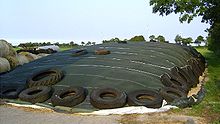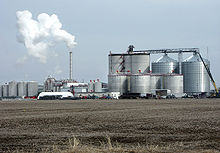Bioconversion
When bioconversion ( give a wiki. Βίος bíos " life " and lat. Conversio "turning around", "reverse") refers to the conversion, mostly of organic compounds ( biomass ), usable in energy or material products. The conversion takes place through organisms , mostly microorganisms , or through isolated enzymes or enzyme systems ( metabolic pathways ). Above all, biotechnological processes such as fermentation ( biogas production , industrial biotechnology ) and enzymatic conversion are used. Bioconversation also takes place in applications that cannot or cannot be clearly assigned to biotechnology, such as B. when baking bread or making sauerkraut ( ethanol and lactic acid fermentation ).
Occasionally the term bioconversion is used as a synonym for biocatalysis and biotransformation . In some cases, however, there is also a differentiation in which bioconversion is classified as a sub-area of biocatalysis.
biochemistry


During a bioconversion, a chemical reaction takes place which is catalyzed by the isolated enzymes or the enzymes present in the organisms used. Different types of bioconversion can be classified, which differ in the principle according to which the product of interest is formed.
Metabolic waste
The first human applications of bioconversion took place thousands of years ago. So the ethanol fermentation for beer and wine production and the lactic acid fermentation z. B. used to preserve milk by acidification ( yogurt , kefir ). In these applications, microorganisms ( yeasts , bacteria ) are used, which convert organic compounds (mainly sugar ) primarily for energy supply ( catabolism ). Since this conversion takes place under anaerobic (oxygen-free) conditions or by anaerobic organisms, there is no complete conversion of the organic compounds (especially to CO 2 and H 2 O), but to organic compounds such as ethanol (alcohol) and lactic acid .
Not only in the food industry, but also for material and energetic use, such as B. as a raw material for the production of bio-based plastics (e.g. polylactide from lactic acid) or biofuel (e.g. so-called bioethanol as a substitute for or admixture with gasoline), a bioconversion of so-called renewable raw materials takes place.
Many other products are obtained according to this principle:
- acetone
- the propanediols: 1,2-propanediol and 1,3-propanediol
- Carboxylic acids such as acetic acid (acetate), succinic acid (succinate), and lactic acid (lactate)
- Biogas
Metabolic products
From organic compounds or certain inorganic compounds, heterotrophic or autotrophic creatures can synthesize compounds that serve as building materials for the cell ( anabolism ). This synthesis is a form of bioconversion that is used for various purposes. Examples are the production of antibiotics such. B. penicillin with the fungus Penicillium chrysogenum , of lysine and glutamic acid ( amino acids ) with the bacterium Corynebacterium glutamicum or the peptide insulin in the bacterium Escherichia coli .
The synthesis of compounds such as penicillin is energy-intensive, which is why organisms only produce them in small quantities. The yield can be significantly increased through breeding and selection as well as the choice of certain conditions during cultivation . Other options include changing metabolic pathways ( metabolic engineering ) or introducing new metabolic pathways from other organisms using genetic engineering . For example, the human gene was transferred into bacteria to produce insulin .
The production usually takes place under sterile conditions in a fermenter , as impurities could disrupt the process. In addition, pharmaceutical products such as insulin require a high level of purity.
Metabolic performance
Metabolic performance of living things can be used to z. B. to degrade toxic or odorous compounds or waste water polluting substances such. B. nitrogen compounds to bind. This applies z. B. in contaminated soils, in the treatment of exhaust air in biofilters or the fixation of nitrogen and phosphorus compounds dissolved in water during treatment in a sewage treatment plant .
Products of isolated enzymes
Isolated enzymes and enzyme systems can catalyze certain reactions. For example, rennet - a mixture of different enzymes - is obtained from calf stomachs and used in cheese production. Various enzymes can also play a role in the production of leather . Among other things, fat- and protein-degrading enzymes ( lipases or proteases ) are found in detergents .
Classification by area of application
- (see also article biotechnology )
In biotechnology there is usually no classification based on the principle of bioconversion, but rather according to the area of application. In white biotechnology , also known as industrial biotechnology, all of the principles mentioned are applied. There is also red biotechnology (medical biotechnology) and green biotechnology (plant biotechnology ). Other, so far less clearly defined biotechnologies are gray biotechnology and blue biotechnology . Other colors (brown and yellow biotechnology) are occasionally used but are not clearly assigned. In addition to bioconversions, biotechnologies can also include other applications in which chemical reactions also take place. However, the reaction or the product produced are not in the foreground, e.g. B. in diagnostic methods of red biotechnology.
meaning
Bioconversion plays an important role in many technical processes. It enables the creation of compounds that cannot be synthesized using other methods. In the chemical industry, chemical processes are occasionally converted to bioconversion (biochemical processes), as these often require less extreme conditions and thus energy and chemicals can be saved. Classic and new processes are used to make renewable raw materials usable. Large amounts of ethanol are made from sugar and starch.
By means of new processes of bioconversion, parts of the biomass that were previously not usable as fuel, such as the lignocellulose-containing straw and wood, are to be developed as cellulosic ethanol or cellulosic butanol . Another approach is synthesis gas fermentation, in which biomass is converted into synthesis gas via biomass gasification and then converted into usable alcohols and other chemicals in fermentation. Since cellulose makes up a large proportion of biomass, it offers great, so far hardly used potential for the provision of energy and raw materials.
swell
- ^ Glossary on the website of the Helmholtz Center for Environmental Research (UFZ), accessed on January 10, 2010
- ^ Garabed Antranikian: "Applied Microbiology", 1st edition, Springer-Verlag Berlin Heidelberg 2006, ISBN 3-540-24083-7
- ↑ a b "Research Industrial Biotechnology" on the website of the Institute for Bioprocess Engineering of the Technical University of Braunschweig
literature
- B. Kamm, P. Gruber, M. Kamm: Biorefineries - Industrial Processes and Products. Wiley-VCH, Weinheim 2006; u. a. P. 104, ISBN 978-3-527-31027-2 .
- Garabed Antranikian : Applied Microbiology , 1st edition, Springer-Verlag Berlin Heidelberg 2006, ISBN 3-540-24083-7


